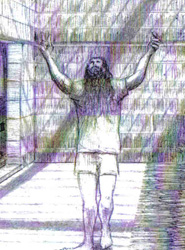This story was first published on the website openDemocracy on September 6, 2010.
For Nelson Mandela it was the most forbidding aspect of prison life. When he looked back on the 27 years he spent as a political prisoner in his memoir, The Long Walk to Freedom, Mandela remembered solitary confinement as the experience that came nearest to breaking him.
“There is no end and no beginning; there is only one’s mind, which can begin to play tricks,” he wrote. “Was that a dream or did it really happen? One begins to question everything.”
The harmful effects of locking someone up in isolation have long been known about. As far back as the mid-19th century medical reports observed the impact. Between 1854 and 1909 there were nearly 40 reports in Germany alone, all of which identified solitary confinement as the major factor in the development of psychotic illness among prisoners.
In 1850, doctors in England were noting the high proportion of inmates that had to be removed from cells in Pentonville prison on the grounds of insanity – 32 out of every 1,000.
It was this body of evidence that played a key role in the gradual unravelling of the system of large-scale solitary confinement in the late nineteenth century. In America too, where the system had its roots among the Quaker communities of Pennsylvania, who believed that silent reflection in separate cells was the best way for criminals to do penance (hence, the penitentiary), it came to be recognised that isolating prisoners for long periods was both inhumane and ineffective. In 1890, the United States Supreme Court came close to declaring the punishment to be unconstitutional.
A century on and the lessons from history have either been forgotten or they are being wilfully ignored. In America, its use in a burgeoning prison system has increased dramatically in the last 20 years.
This increase has coincided with the growth of the so-called supermax prisons, a new generation of high security jails designed to keep social contact between inmates to a minimum.
The US now holds more people in solitary than anywhere else in the world. An accurate figure is almost impossible to come by, since the population within the punishment blocks of general prisons, known as Special Housing Units (SHUs), is too transient to monitor. Even so, observers estimate the numbers somewhere between 25,000 and 80,000.
At the Federally-run supermax prison in Florence, Colorado, inmates considered to be the greatest security risk are kept in conditions of extreme isolation that would leave even the Pennsylvania Quakers in awe.
High profile prisoners like Ted Kaczynski, the Unabomber, and Arab terrorists convicted of arranging the 1993 World Trade Center bombing are kept in rooms constructed of poured concrete and steel for 23 hours a day. The windowless cells are illuminated day and night and are heavily insulated so that the inmates are denied either the sight or sound of other human life.
One inmate held in Florence is Tommy Silverstein. He has been kept in solitary for 27 years now, longer than anyone else in the Federal prison system. Silverstein was made the subject of a “no-human-contact” order by a judge after he murdered a prison guard in 1983. For much of his isolation he was held in a specially built unit — known as the Silverstein Suite — at a prison in Kansas where he had his own exercise yard. This meant his only human contact was with the guards or via the occasional visit, where a thick layer of plexiglass maintained his isolation. He has referred to his existence as “a slow, constant peeling of the skin.”
Laura Rovner, a law professor at Denver University, represents Silverstein, 58, in his case to have his isolation ended. Rovner wants the courts to recognise his treatment as “cruel and unusual punishment,” and therefore unlawful under the eighth amendment of the US constitution.
It is the same argument put forward by activists in Louisiana on behalf of the Angola three, a trio who between them have spent over a century in solitary. Two of the men, Herman Wallace and Albert Woodfox have been nearly 38 years in isolation. A third man, Robert King was kept there 29 years before he was released in 2001 after a series of appeals.
Much of Rovner’s case is concerned with laying bare the harmful psychological effects of Silverstein’s condition. There are a number of contemporary studies of inmates in isolation and, just like their 19th century predecessors, most express grave concern.
“What you see when reading these studies is the same constellation of symptoms coming up in different cases, and they’re simply too common not to be a pathology arising from the isolation,” said Rovner.
That constellation of symptoms includes agitated and self-destructive behaviour, anxiety and hypersensitivity, auditory and visual hallucinations and, in some cases, a permanent intolerance to being around others.
Rovner said the impact of his lone existence was evident during legal visits with Silverstein. “At the start of our meetings with him just an hour spent with us would send him into a tailspin for a couple of days, needing to sleep for 15 or 16 hours at a time.”
Professor Craig Haney, a psychologist at the University of California who evaluated over a hundred supermax prisoners and who has compiled a report for Rovner on Silverstein, wrote that “many of those subjected to it (solitary confinement) are at risk of long term emotional and even physical damage.”
The only one of the ‘Angola three’ at liberty, Robert King, said his ability to see distance was permanently altered by his years alone in a cell. “I had no concept of how you actually looked further, as a result of living in such a small space,” he said.
King now campaigns for the release of Woodfox and Wallace. The men’s isolation stems from their conviction for the killing of a prison guard, found stabbed to death in the early seventies in Louisiana State Penitentiary, also known as Angola.
Wallace, 68, and Woodfox, 63, have always denied the killing and insist their convictions and continued isolation are punishment for their political views. At the time they had started a chapter of the Black Panthers at the prison.
The men’s case gained international recognition in recent years thanks in part to the efforts of Anita Roddick, the late Bodyshop founder. Roddick’s involvement inspired her friend, British filmmaker Vadim Jean to make a documentary about the case called In the Land of the Free, and released earlier this year.
Rovner said the publicity surrounding the Angola three was part of a growing clamour for the US to change its approach. The legislature in Maine recently considered an amendment aimed at abolishing the use of solitary in the state. Meanwhile, a ruling in July in the European Court of Human Rights upheld a complaint by four British nationals facing extradition to the US on terrorism charges that they faced having their human rights violated if, as was likely, they were transferred to solitary at the supermax unit in Florence.
Yet in spite of this, there is no end in sight for Silverstein, as well as Woodfox and Wallace. All of whom had their recent appeals turned down.
“Sadly, the overwhelming public sentiment here is that they are getting what they deserve,” said Rovner. “The irony, however, is that if you asked anyone in long-term lockdown they would freely tell you they’d prefer the death penalty to what they’ve endured.”



